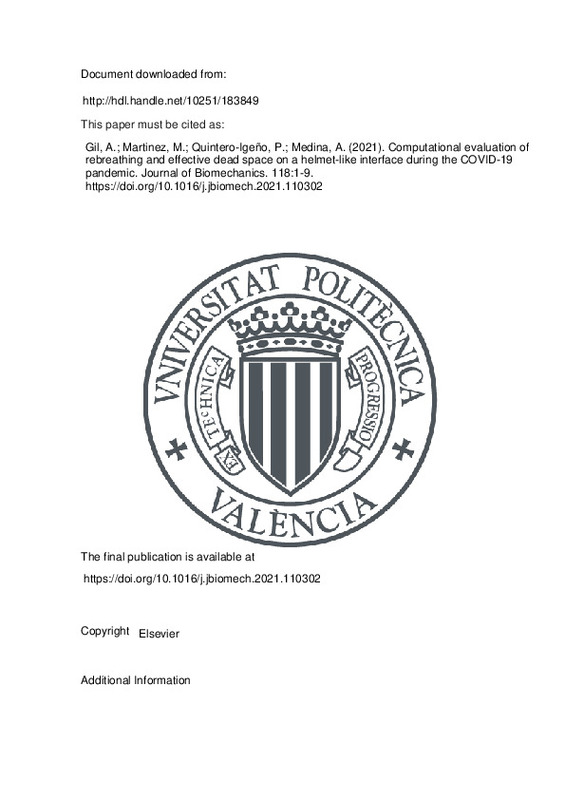JavaScript is disabled for your browser. Some features of this site may not work without it.
Buscar en RiuNet
Listar
Mi cuenta
Estadísticas
Ayuda RiuNet
Admin. UPV
Computational evaluation of rebreathing and effective dead space on a helmet-like interface during the COVID-19 pandemic
Mostrar el registro sencillo del ítem
Ficheros en el ítem
| dc.contributor.author | Gil, A.
|
es_ES |
| dc.contributor.author | Martinez, M.
|
es_ES |
| dc.contributor.author | Quintero-Igeño, Pedro-Manuel
|
es_ES |
| dc.contributor.author | Medina, A.
|
es_ES |
| dc.date.accessioned | 2022-07-05T18:05:50Z | |
| dc.date.available | 2022-07-05T18:05:50Z | |
| dc.date.issued | 2021-03-30 | es_ES |
| dc.identifier.issn | 0021-9290 | es_ES |
| dc.identifier.uri | http://hdl.handle.net/10251/183849 | |
| dc.description.abstract | [EN] The coronavirus disease 2019 (COVID-19) is a potentially severe acute respiratory infection caused by severe acute respiratory syndrome coronavirus 2. The potential for transmission of this disease has led to an important scarcity of health-care resources. Consequently, alternative solutions have been explored by many physicians and researchers. Non-invasive Ventilation has been revealed as one alternative for patients with associated acute respiratory distress syndrome. This technique is being used in combination with helmet-like interfaces because of their versatility and affordability. However, these interfaces could experience important problems of CO2 rebreathing, especially under low flow rate conditions. This work proposes a Computational Fluid Dynamics method to accurately characterize the fluid flow in a pre-design environment of helmet-like interfaces. Parameters as effective dead space, rebreathing, pressure, or temperature field distribution are quantified and analysed in detail in order to study the performance and feasibility of such devices to relieve the effects of respiratory infections. (C) 2021 Elsevier Ltd. All rights reserved. | es_ES |
| dc.language | Inglés | es_ES |
| dc.publisher | Elsevier | es_ES |
| dc.relation.ispartof | Journal of Biomechanics | es_ES |
| dc.rights | Reconocimiento - No comercial - Sin obra derivada (by-nc-nd) | es_ES |
| dc.subject | Non-invasive ventilation | es_ES |
| dc.subject | Helmet interface | es_ES |
| dc.subject | COVID-19 | es_ES |
| dc.subject | Computational fluid dynamics | es_ES |
| dc.subject | Unsteady Reynolds averaged Navier stokes | es_ES |
| dc.subject.classification | INGENIERIA AEROESPACIAL | es_ES |
| dc.subject.classification | MAQUINAS Y MOTORES TERMICOS | es_ES |
| dc.title | Computational evaluation of rebreathing and effective dead space on a helmet-like interface during the COVID-19 pandemic | es_ES |
| dc.type | Artículo | es_ES |
| dc.identifier.doi | 10.1016/j.jbiomech.2021.110302 | es_ES |
| dc.rights.accessRights | Abierto | es_ES |
| dc.contributor.affiliation | Universitat Politècnica de València. Departamento de Máquinas y Motores Térmicos - Departament de Màquines i Motors Tèrmics | es_ES |
| dc.description.bibliographicCitation | Gil, A.; Martinez, M.; Quintero-Igeño, P.; Medina, A. (2021). Computational evaluation of rebreathing and effective dead space on a helmet-like interface during the COVID-19 pandemic. Journal of Biomechanics. 118:1-9. https://doi.org/10.1016/j.jbiomech.2021.110302 | es_ES |
| dc.description.accrualMethod | S | es_ES |
| dc.relation.publisherversion | https://doi.org/10.1016/j.jbiomech.2021.110302 | es_ES |
| dc.description.upvformatpinicio | 1 | es_ES |
| dc.description.upvformatpfin | 9 | es_ES |
| dc.type.version | info:eu-repo/semantics/publishedVersion | es_ES |
| dc.description.volume | 118 | es_ES |
| dc.identifier.pmid | 33578054 | es_ES |
| dc.identifier.pmcid | PMC7857993 | es_ES |
| dc.relation.pasarela | S\435629 | es_ES |







![[Cerrado]](/themes/UPV/images/candado.png)

